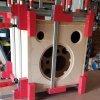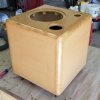A friend of my son asked me to build him a set of the Flint Acoustics Lil Jokers coaxial speakers and The Arthur sub but intended for high fidelity indoor use. The original versions of this system were designed for outdoor applications which called for sealed enclosures and a brighter, sharper sound.
After much design work, I came up with a system which is functionally similar and priced about the same, but should provide better fidelity. All of the enclosures are vented, but they can be sealed if it makes sense.
They are still under construction, but here's some photos.
The MDF panels cut for the speakers:

Dry fitting the parts:

Dry fitting, showing the bracing to reduce vibrations and breakup the acoustic reflections:

Clamping the sides, back, and braces together after glue-up

After much design work, I came up with a system which is functionally similar and priced about the same, but should provide better fidelity. All of the enclosures are vented, but they can be sealed if it makes sense.
They are still under construction, but here's some photos.
The MDF panels cut for the speakers:
Dry fitting the parts:

Dry fitting, showing the bracing to reduce vibrations and breakup the acoustic reflections:

Clamping the sides, back, and braces together after glue-up
















